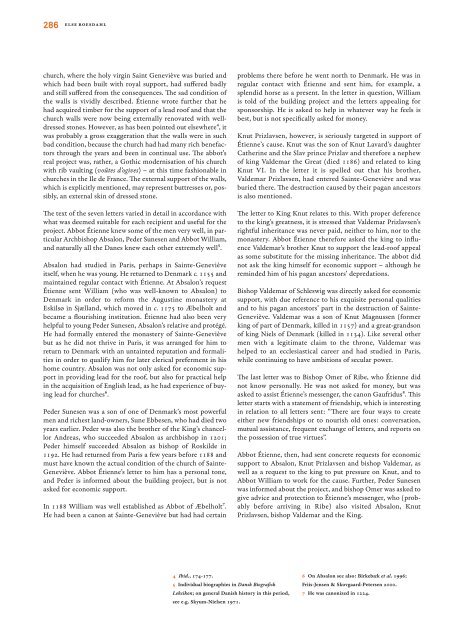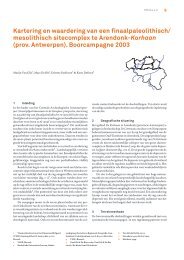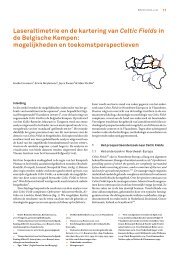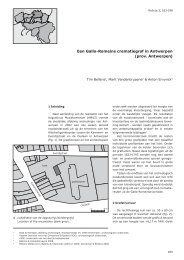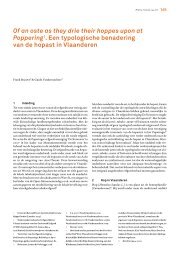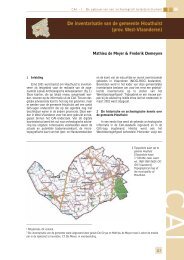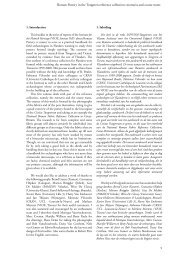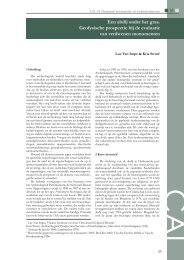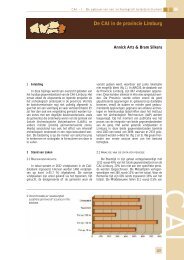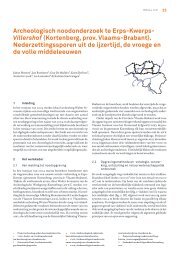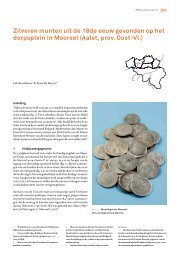Exchanging Medieval Material Culture Studies on archaeology and ...
Exchanging Medieval Material Culture Studies on archaeology and ...
Exchanging Medieval Material Culture Studies on archaeology and ...
Create successful ePaper yourself
Turn your PDF publications into a flip-book with our unique Google optimized e-Paper software.
286<br />
Else Roesdahl<br />
church, where the holy virgin Saint Geneviève was buried <strong>and</strong><br />
which had been built with royal support, had suff ered badly<br />
<strong>and</strong> still suff ered from the c<strong>on</strong>sequences. Th e sad c<strong>on</strong>diti<strong>on</strong> of<br />
the walls is vividly described. Étienne wrote further that he<br />
had acquired timber for the support of a lead roof <strong>and</strong> that the<br />
church walls were now being externally renovated with welldressed<br />
st<strong>on</strong>es. However, as has been pointed out elsewhere4, it<br />
was probably a gross exaggerati<strong>on</strong> that the walls were in such<br />
bad c<strong>on</strong>diti<strong>on</strong>, because the church had had many rich benefactors<br />
through the years <strong>and</strong> been in c<strong>on</strong>tinual use. Th e abbot’s<br />
real project was, rather, a Gothic modernisati<strong>on</strong> of his church<br />
with rib vaulting (voûtes d’ogives) – at this time fashi<strong>on</strong>able in<br />
churches in the Ile de France. Th e external support of the walls,<br />
which is explicitly menti<strong>on</strong>ed, may represent buttresses or, possibly,<br />
an external skin of dressed st<strong>on</strong>e.<br />
Th e text of the seven letters varied in detail in accordance with<br />
what was deemed suitable for each recipient <strong>and</strong> useful for the<br />
project. Abbot Étienne knew some of the men very well, in particular<br />
Archbishop Absal<strong>on</strong>, Peder Sunesen <strong>and</strong> Abbot William,<br />
<strong>and</strong> naturally all the Danes knew each other extremely well5.<br />
Absal<strong>on</strong> had studied in Paris, perhaps in Sainte-Geneviève<br />
itself, when he was young. He returned to Denmark c. 1155 <strong>and</strong><br />
maintained regular c<strong>on</strong>tact with Étienne. At Absal<strong>on</strong>’s request<br />
Étienne sent William (who was well-known to Absal<strong>on</strong>) to<br />
Denmark in order to reform the Augustine m<strong>on</strong>astery at<br />
Eskilsø in Sjæll<strong>and</strong>, which moved in c. 1175 to Æbelholt <strong>and</strong><br />
became a fl ourishing instituti<strong>on</strong>. Étienne had also been very<br />
helpful to young Peder Sunesen, Absal<strong>on</strong>’s relative <strong>and</strong> protégé.<br />
He had formally entered the m<strong>on</strong>astery of Sainte-Geneviève<br />
but as he did not thrive in Paris, it was arranged for him to<br />
return to Denmark with an untainted reputati<strong>on</strong> <strong>and</strong> formalities<br />
in order to qualify him for later clerical preferment in his<br />
home country. Absal<strong>on</strong> was not <strong>on</strong>ly asked for ec<strong>on</strong>omic support<br />
in providing lead for the roof, but also for practical help<br />
in the acquisiti<strong>on</strong> of English lead, as he had experience of buying<br />
lead for churches6.<br />
Peder Sunesen was a s<strong>on</strong> of <strong>on</strong>e of Denmark’s most powerful<br />
men <strong>and</strong> richest l<strong>and</strong>-owners, Sune Ebbesen, who had died two<br />
years earlier. Peder was also the brother of the King’s chancellor<br />
Andreas, who succeeded Absal<strong>on</strong> as archbishop in 1201;<br />
Peder himself succeeded Absal<strong>on</strong> as bishop of Roskilde in<br />
1192. He had returned from Paris a few years before 1188 <strong>and</strong><br />
must have known the actual c<strong>on</strong>diti<strong>on</strong> of the church of Sainte-<br />
Geneviève. Abbot Étienne’s letter to him has a pers<strong>on</strong>al t<strong>on</strong>e,<br />
<strong>and</strong> Peder is informed about the building project, but is not<br />
asked for ec<strong>on</strong>omic support.<br />
In 1188 William was well established as Abbot of Æbelholt7.<br />
He had been a can<strong>on</strong> at Sainte-Geneviève but had had certain<br />
4 Ibid., 174-177.<br />
5 Individual biographies in Dansk Biografi sk<br />
Leksik<strong>on</strong>; <strong>on</strong> general Danish history in this period,<br />
see e.g. Skyum-Nielsen 1971.<br />
problems there before he went north to Denmark. He was in<br />
regular c<strong>on</strong>tact with Étienne <strong>and</strong> sent him, for example, a<br />
splendid horse as a present. In the letter in questi<strong>on</strong>, William<br />
is told of the building project <strong>and</strong> the letters appealing for<br />
sp<strong>on</strong>sorship. He is asked to help in whatever way he feels is<br />
best, but is not specifi cally asked for m<strong>on</strong>ey.<br />
Knut Prizlavsen, however, is seriously targeted in support of<br />
Étienne’s cause. Knut was the s<strong>on</strong> of Knut Lavard’s daughter<br />
Catherine <strong>and</strong> the Slav prince Prizlav <strong>and</strong> therefore a nephew<br />
of king Valdemar the Great (died 1186) <strong>and</strong> related to king<br />
Knut VI. In the letter it is spelled out that his brother,<br />
Valdemar Prizlavsen, had entered Sainte-Geneviève <strong>and</strong> was<br />
buried there. Th e destructi<strong>on</strong> caused by their pagan ancestors<br />
is also menti<strong>on</strong>ed.<br />
Th e letter to King Knut relates to this. With proper deference<br />
to the king’s greatness, it is stressed that Valdemar Prizlavsen’s<br />
rightful inheritance was never paid, neither to him, nor to the<br />
m<strong>on</strong>astery. Abbot Étienne therefore asked the king to infl uence<br />
Valdemar’s brother Knut to support the lead-roof appeal<br />
as some substitute for the missing inheritance. Th e abbot did<br />
not ask the king himself for ec<strong>on</strong>omic support – although he<br />
reminded him of his pagan ancestors’ depredati<strong>on</strong>s.<br />
Bishop Valdemar of Schleswig was directly asked for ec<strong>on</strong>omic<br />
support, with due reference to his exquisite pers<strong>on</strong>al qualities<br />
<strong>and</strong> to his pagan ancestors’ part in the destructi<strong>on</strong> of Sainte-<br />
Geneviève. Valdemar was a s<strong>on</strong> of Knut Magnussen (former<br />
king of part of Denmark, killed in 1157) <strong>and</strong> a great-gr<strong>and</strong>s<strong>on</strong><br />
of king Niels of Denmark (killed in 1134). Like several other<br />
men with a legitimate claim to the thr<strong>on</strong>e, Valdemar was<br />
helped to an ecclesiastical career <strong>and</strong> had studied in Paris,<br />
while c<strong>on</strong>tinuing to have ambiti<strong>on</strong>s of secular power.<br />
Th e last letter was to Bishop Omer of Ribe, who Étienne did<br />
not know pers<strong>on</strong>ally. He was not asked for m<strong>on</strong>ey, but was<br />
asked to assist Étienne’s messenger, the can<strong>on</strong> Gaufridus8. Th is<br />
letter starts with a statement of friendship, which is interesting<br />
in relati<strong>on</strong> to all letters sent: “Th ere are four ways to create<br />
either new friendships or to nourish old <strong>on</strong>es: c<strong>on</strong>versati<strong>on</strong>,<br />
mutual assistance, frequent exchange of letters, <strong>and</strong> reports <strong>on</strong><br />
the possessi<strong>on</strong> of true virtues”.<br />
Abbot Étienne, then, had sent c<strong>on</strong>crete requests for ec<strong>on</strong>omic<br />
support to Absal<strong>on</strong>, Knut Prizlavsen <strong>and</strong> bishop Valdemar, as<br />
well as a request to the king to put pressure <strong>on</strong> Knut, <strong>and</strong> to<br />
Abbot William to work for the cause. Further, Peder Sunesen<br />
was informed about the project, <strong>and</strong> bishop Omer was asked to<br />
give advice <strong>and</strong> protecti<strong>on</strong> to Étienne’s messenger, who (probably<br />
before arriving in Ribe) also visited Absal<strong>on</strong>, Knut<br />
Prizlavsen, bishop Valdemar <strong>and</strong> the King.<br />
6 On Absal<strong>on</strong> see also: Birkebæk et al. 1996;<br />
Friis-Jensen & Skovgaard-Petersen 2000.<br />
7 He was can<strong>on</strong>ized in 1224.


